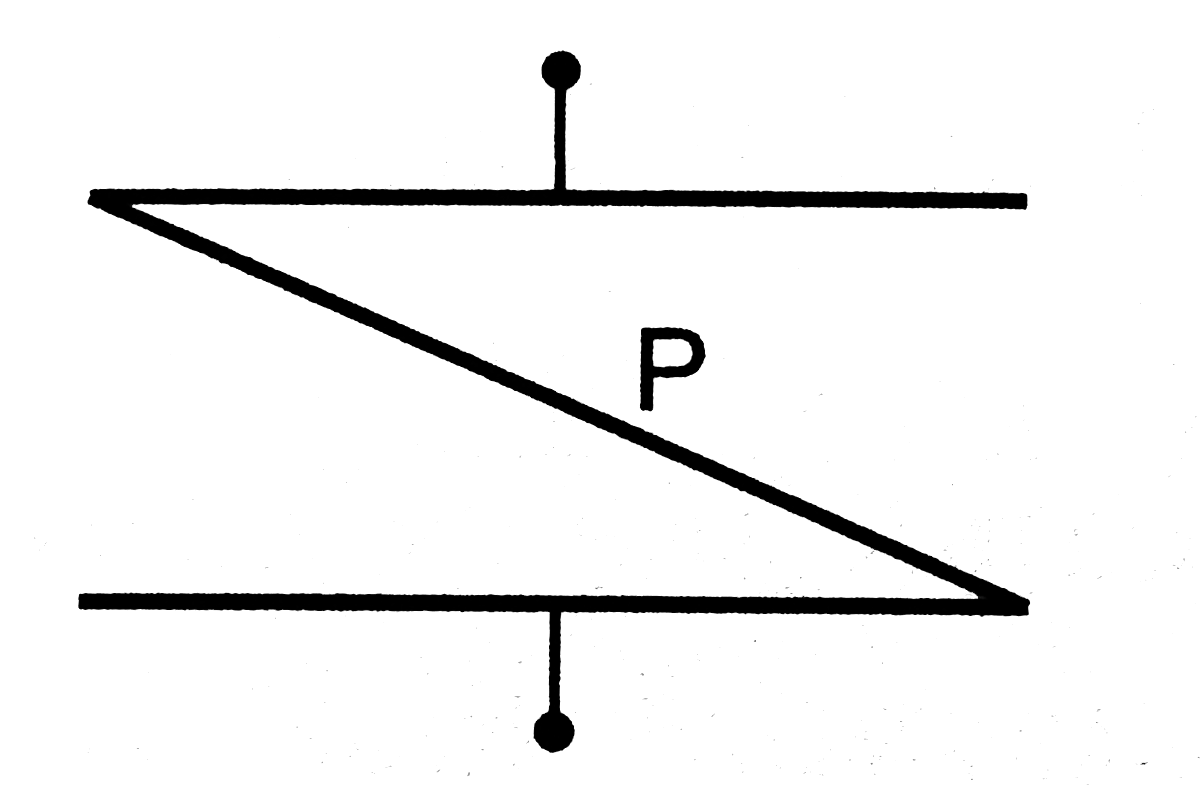The electric field between the plates of a parallel-plate capacitor of capacitance2.0(μ)F drops to one third of its initial value in (4.4μ)s when the plates are connected by a thin wire. Find the resistance of the wire.
To solve the problem step by step, we will follow the reasoning presented in the video transcript and apply the relevant formulas.
Step 1: Understand the problem
We have a parallel-plate capacitor with a capacitance of C=2.0μF that is discharging through a wire. The electric field between the plates drops to one-third of its initial value in a time of t=4.4μs.
Step 2: Relate the electric field to charge
The electric field E between the plates of a capacitor is directly proportional to the charge Q on the plates:
E=QA⋅ϵ0
where A is the area of the plates and ϵ0 is the permittivity of free space. If the electric field drops to one-third, it implies that the charge also drops to one-third of its initial value:
Q=Q0⇒Q=Q03
Step 3: Use the discharge equation
The charge on a discharging capacitor can be expressed as:
Q(t)=Q0e−tτ
where τ=RC is the time constant of the circuit. Setting Q(t)=Q03 gives:
Q03=Q0e−tτ
Dividing both sides by Q0 (assuming Q0≠0):
13=e−tτ
Step 4: Take the natural logarithm
Taking the natural logarithm of both sides:
ln(13)=−tτ
This can be rearranged to:
tτ=−ln(13)=ln(3)
Step 5: Substitute for τ
Now we can express τ in terms of t:
τ=tln(3)
Substituting the given time t=4.4μs=4.4×10−6s:
τ=4.4×10−6ln(3)
Step 6: Relate τ to R and C
Since τ=RC, we can express the resistance R as:
R=τC
Substituting C=2.0μF=2.0×10−6F:
R=4.4×10−62.0×10−6⋅ln(3)
Step 7: Calculate R
Now we calculate R:
R=4.4×10−62.0×10−6⋅ln(3)≈4.42⋅ln(3)Ω
Using ln(3)≈1.0986:
R≈4.42⋅1.0986≈4.42.1972≈2.0Ω
Final Answer
The resistance of the wire is approximately R≈2Ω.
---
We have a parallel-plate capacitor with a capacitance of C=2.0μF that is discharging through a wire. The electric field between the plates drops to one-third of its initial value in a time of t=4.4μs.
The electric field E between the plates of a capacitor is directly proportional to the charge Q on the plates:
E=QA⋅ϵ0
where A is the area of the plates and ϵ0 is the permittivity of free space. If the electric field drops to one-third, it implies that the charge also drops to one-third of its initial value:
Q=Q0⇒Q=Q03
The charge on a discharging capacitor can be expressed as:
Q(t)=Q0e−tτ
where τ=RC is the time constant of the circuit. Setting Q(t)=Q03 gives:
Q03=Q0e−tτ
Dividing both sides by Q0 (assuming Q0≠0):
13=e−tτ
Taking the natural logarithm of both sides:
ln(13)=−tτ
This can be rearranged to:
tτ=−ln(13)=ln(3)
Now we can express τ in terms of t:
τ=tln(3)
Substituting the given time t=4.4μs=4.4×10−6s:
τ=4.4×10−6ln(3)
Since τ=RC, we can express the resistance R as:
R=τC
Substituting C=2.0μF=2.0×10−6F:
R=4.4×10−62.0×10−6⋅ln(3)
Now we calculate R:
R=4.4×10−62.0×10−6⋅ln(3)≈4.42⋅ln(3)Ω
Using ln(3)≈1.0986:
R≈4.42⋅1.0986≈4.42.1972≈2.0Ω
The resistance of the wire is approximately R≈2Ω.
Topper's Solved these Questions
- BOOK - CENGAGE PHYSICS ENGLISHCHAPTER - ELECTRIC CURRENT AND CIRCUITEXERCISE - Subjective29videos
ELECTRIC CURRENT AND CIRCUIT
- BOOK - CENGAGE PHYSICS ENGLISHCHAPTER - ELECTRIC CURRENT AND CIRCUITEXERCISE - Single Correct72videos
ELECTRIC CURRENT AND CIRCUIT
- BOOK - CENGAGE PHYSICS ENGLISHCHAPTER - ELECTRIC CURRENT AND CIRCUITEXERCISE - Exercise 5.128videos
ELECTRIC CURRENT AND CIRCUIT
- BOOK - CENGAGE PHYSICS ENGLISHCHAPTER - ELECTRIC CURRENT & CIRCUITSEXERCISE - Kirchhoff s law and simple circuits15videos
ELECTRIC CURRENT & CIRCUITS
- BOOK - CENGAGE PHYSICS ENGLISHCHAPTER - ELECTRIC FLUX AND GAUSS LAWEXERCISE - MCQ s38videos
ELECTRIC FLUX AND GAUSS LAW
Similar Questions
The voltage between the plates of a parallel plate capacitor of capacitance 1.0μFis changing at rate of 1.0V/s. Find displacement current
View SolutionA thin metal plate P is inserted between the plates of a parallel-plate capacitor of capacitanceCin such a way that its edges touch the two plates (figure 31-Q2).The capacitance now becomes.
 View Solution
View SolutionA thin metal plate P is inserted between the plates of a parallel-plate capacitor of capacitance C in such a way that its edges touch the two plates (figure 31-Q2).The capacitance now becomes.
 View Solution
View SolutionA thin metal plate P is inserted between the plates of a parallel-plate capacitor of capacitance C in such a way that its edges touch the two plates (figure 31-Q2).The capacitance now becomes.
 View Solution
View SolutionThe' distance between the plates of a parallel plate capacitor is d. A metal plate of thickness d/2 is placed between the plates. What will e its effect on the capacitance.
View SolutionA charge of 1μC is given to one plate of a parallel - plate capacitor of capacitance 0.1μF and a charge of 2μC is given to the other plate . Find the potential difference developed between the plate .
View SolutionThe magnetic field between the plates of radius 12 cm separated by distance of 4mm of a parallel plate capacitor of capacitance 100 pF. along the axis of plates having conduction current of 0.15 A is
View SolutionThe electrostatic energy stored in a parallel-plate capacitor of capacitance 2μF is 10mJ. If the separation between the plates of the capacitor is 1mm, the elctric field inside the capacitor is 10XN/C. The value of X is_____.
View SolutionThe distance between the plates of a parallel plate capacitor is 0.04m A field of 5000V/m is established between the plates and an unchanged metal plate of thickness 0.01m is inserted intothe condenser parallel to its plate. Find the p.d. between the plates (a) before the introducing of the metal plate and (b) after its introduction. what would be the p.d. if plate of dielectric constant K=2 is introduced in place of metal plate?
View SolutionThe capacitance of a parallel plate capacitor is 2μF and the charge on its positive plate is 2μC. If the charge on its plates is doubled, the capacitance of the capacitor
View Solution

